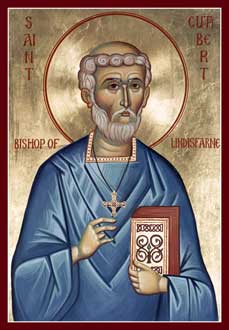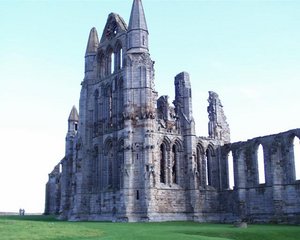Cuthbert de Lindisfarne: Diferență între versiuni
(→Legături externe) |
m |
||
| Linia 4: | Linia 4: | ||
==Viața== | ==Viața== | ||
| − | Not much is known for certain of Cuthbert's youth. Variously, he has been thought to have been of Irish origin, named "Mulloche" and descended from Irish royalty, or of Northumbrian birth of well-to-do English stock, with either warrior or sheep-herding training. He was raised in the Scottish lowlands by a poor widow named Kenswith. His date of birth is given as 634 or 635. His course in life seems to have turned on an experience when he was tending sheep one night. Cuthbert saw lights in the sky that he interpreted to be an [[înger]] descending to earth and returning to [[heaven]] with the [[soul]] of St. [[Aidan | + | Not much is known for certain of Cuthbert's youth. Variously, he has been thought to have been of Irish origin, named "Mulloche" and descended from Irish royalty, or of Northumbrian birth of well-to-do English stock, with either warrior or sheep-herding training. He was raised in the Scottish lowlands by a poor widow named Kenswith. His date of birth is given as 634 or 635. His course in life seems to have turned on an experience when he was tending sheep one night. Cuthbert saw lights in the sky that he interpreted to be an [[înger]] descending to earth and returning to [[heaven]] with the [[soul]] of St. [[Aidan de Lindisfarne]], whom he found later to have died that evening, [[31 august]], 651. Through this event he decided to go to the Melrose [[Abbey]] on the Tweed River and become a [[monk]]. |
Cuthbert was a monk at Melrose under St. Eata from 651 to 661 where he was taught the [[Holy Scripture|scriptures]] by the [[prior]], St. Boisil. In 661, he joined a new [[monastery]] at Ripon, with St. Eata, where he was the guestmaster. Cuthbert returned to Melrose, after King Alcfrid placed Ripon under St. Wilfrid's leadership, and there he became the prior after the death St. Boisil. It was while at Melrose that Cuthbert began his missionary efforts throughout Northumbria. He became ill with the plague that was endemic in the area, and which had been the cause of the death of Boisil. While Cuthbert recovered his health henceforth was undermined. | Cuthbert was a monk at Melrose under St. Eata from 651 to 661 where he was taught the [[Holy Scripture|scriptures]] by the [[prior]], St. Boisil. In 661, he joined a new [[monastery]] at Ripon, with St. Eata, where he was the guestmaster. Cuthbert returned to Melrose, after King Alcfrid placed Ripon under St. Wilfrid's leadership, and there he became the prior after the death St. Boisil. It was while at Melrose that Cuthbert began his missionary efforts throughout Northumbria. He became ill with the plague that was endemic in the area, and which had been the cause of the death of Boisil. While Cuthbert recovered his health henceforth was undermined. | ||
Versiunea de la data 31 august 2015 16:40
| Acest articol (sau părți din el) este propus spre traducere din limba engleză!
Dacă doriți să vă asumați acestă traducere (parțial sau integral), anunțați acest lucru pe pagina de discuții a articolului. |
Cel întru sfinţi Părintele nostru Cuthbert deLindisfarne, făcător de minuni din Britania, a fost un călugăr misionar și episcop din secolul al șaptelea, în Scoția și nordul Angliei. Este unul din cei mai cinstiți sfinți din Anglia. Prăznuirea lui se face la 20 martie, iar la 4 septembrie este comemorată mutarea moaștelor în Durham.
Viața
Not much is known for certain of Cuthbert's youth. Variously, he has been thought to have been of Irish origin, named "Mulloche" and descended from Irish royalty, or of Northumbrian birth of well-to-do English stock, with either warrior or sheep-herding training. He was raised in the Scottish lowlands by a poor widow named Kenswith. His date of birth is given as 634 or 635. His course in life seems to have turned on an experience when he was tending sheep one night. Cuthbert saw lights in the sky that he interpreted to be an înger descending to earth and returning to heaven with the soul of St. Aidan de Lindisfarne, whom he found later to have died that evening, 31 august, 651. Through this event he decided to go to the Melrose Abbey on the Tweed River and become a monk.
Cuthbert was a monk at Melrose under St. Eata from 651 to 661 where he was taught the scriptures by the prior, St. Boisil. In 661, he joined a new monastery at Ripon, with St. Eata, where he was the guestmaster. Cuthbert returned to Melrose, after King Alcfrid placed Ripon under St. Wilfrid's leadership, and there he became the prior after the death St. Boisil. It was while at Melrose that Cuthbert began his missionary efforts throughout Northumbria. He became ill with the plague that was endemic in the area, and which had been the cause of the death of Boisil. While Cuthbert recovered his health henceforth was undermined.
At the Sinodul de la Whitby in 664, a decision was made to follow the Roman liturgical customs introduced by Augustin din Canterbury in place of the Celtic practices that were formerly followed. While St. Colman, the local bishop, and his monks refused to accept the decision of the Synod of Whitby and left for Ireland, Cuthbert seemed to have accepted the introduction of the Roman practices and remained. Cuthbert, then, followed his abbot, St. Eata, from Melrose to Lindisfarne, where he became prior and later abbot.
From Lindisfarne, Cuthbert continued his missionary work southward to Northumberland and Durham. Cuthbert had become entranced with the sea and rocky lands of Lindisfarne and yearned for a solitary life there. In 676, he actively turned to such a life by retiring to a cave and shortly thereafter he moved to a cell he built on the isolated island of Inner Farne that was south of Lindisfarne. Yet he was still sought after. After being implored strongly by the king of Northumberland, Cuthbert, in tears, agreed to accept election as a bishop in 684. While initially destined for the see of Hexham, Cuthbert exchanged sees with St. Eata and was consecrated bishop of Lindisfarne in 26 martie, 685, on the Sunday of the Resurrection, by St. Theodore, Archbishop of Canterbury, and by six bishops in York.
For the next two years, Cuthbert, while maintaining an ascetic life, led his diocese by caring for the sick, distributing alms, working the many miracles that earned him the title of Wonder-worker of Britain. Then, during the Christmas season of 686 in declining health he resigned his office and retired to his cell on the Inner Farne Island where he reposed on 20 martie, 687.


